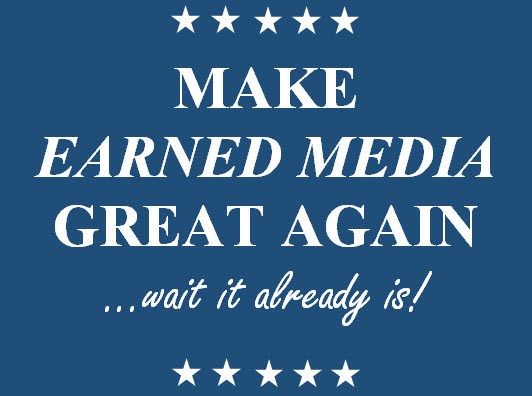A key aspect of any strategic communication campaign is garnering earned media. Did we just witness a presidential campaign mastering earned media?
The difference between the two major party candidates was stark.
Hilary Clinton was structured, had the entire Democratic Party election machine ramped up, had served as First Lady of Arkansas, First Lady of the United States, Senator of New York and Secretary of State.
Donald Trump was undisciplined, a former reality show star, a business man, used his own money to fund his campaign…but had the pulse of a discouraged nation.
When he announced back in the summer of 2015, Donald Trump was not considered by anyone to be a serious contender, not even his own party. Fast forward to November 9th and we are addressing him as President elect Trump.
How did that happen when he was running against an individual whose resume in public office screamed “I am The MOST Qualified” for the presidency?
To over simplify it…Earned Media.
It’s All About the Money
Consider this simply formula: Get the electorate to recognize + know you = a vote.
With all that happens during a presidential campaign one thing all candidates strive for is facetime on the television and digital media.
Running a presidential campaign costs about $1 Billion per candidate if they become their party’s choice.
Total media buys account for $4.4 Billion during a presidential election. That takes primaries and the general election into account. TV media ad buys effectiveness however have been proven to be short lived. How we consume media has changed but the practice of ad buys has not.
“When studying the outcomes of the 2012 presidential election, political scientist John Sides and UCLA political science professor Lynn Vavreck found that while ads had a measurable effect on voter attitudes, that effect was small and remarkably short-lived — it disappeared within a week.” (1http://www.npr.org/sections/itsallpolitics/2015/08/19/432759311/2016-campaign-tv-ad-spending)
In a 24/7/365 news cycle there is no downtime. In a multi-screen world, every view, every second counts. Networks and their shows are pressured to build their audience and ad dollar revenue.
How do you keep people tuned in? What grabs their attention? Controversy, real or perceived or contrived. The media latched on to every extraordinary, unbelievable, unorthodox and controversial statement made by Trump.
As a result, the other candidates were forced to pay for more airtime. The difference was their paid media could not keep up with the earned media Trump managed.
The Trump campaign was unconventional in nearly every aspect of its strategy. For example, the first Trump ad buy was not until August and it was only for $4 Million. Compare that to Clinton’s $61 million up to that point in the campaign.
The media could not resist analyzing, discussing and having every pundit throw in their views on how each and every step outside of the political norm was going to hurt the Trump campaign. Time and again it did not.
Time and again Trump received more earned media drowning out his opponents.
Earned media was not the sole reason for a Trump victory but it played a pivotal role. The other strength of the campaign was providing digestible pieces of information to outline his position. Short and to the point. That President-elect Trump also represented the anti-establishment resonated with American’s who feel left behind.
To quote Speaker Paul Ryan, Donald Trump "turned politics on its head." Perhaps the media strategy was earned media all along.
